Your Behaviorist theory of language acquisition summary images are available in this site. Behaviorist theory of language acquisition summary are a topic that is being searched for and liked by netizens today. You can Get the Behaviorist theory of language acquisition summary files here. Download all free photos and vectors.
If you’re looking for behaviorist theory of language acquisition summary pictures information connected with to the behaviorist theory of language acquisition summary keyword, you have visit the ideal site. Our website always gives you hints for seeking the highest quality video and image content, please kindly hunt and find more informative video articles and images that fit your interests.
Behaviorist Theory Of Language Acquisition Summary. Behaviorists like BF. Strong emphasis on the stimulus the response and the relationship between them. They can be summarised as follows. While most current theory may still not be the final word on second language acquisition it is hoped that teachers will use the ideas in this book as another source alongside of their classroom and language-learning experiences.
 Behaviorist Theory Of Language Acquisition From pdfprof.com
Behaviorist Theory Of Language Acquisition From pdfprof.com
Behaviorism is a psycholinguistic approach to language acquisition dominating the language acquisition scene in the 50s and 60s of the 20 th century viewing it as. Second language acquisition theories initiated as an adjunct of language teaching pedagogy supported by behaviorism the leading and pioneering theory in psychology Myles 2010320. Strong emphasis on the stimulus the response and the relationship between them. Summary of Part II. THEORIES OF LANGUAGE ACQUISITION 3 The main theories of language acquisition and how they differ First of all the Behaviourist theory claims that language is constructed thanks to the exposure and positive reinforcement. THEORIES OF LANGUAGE ACQUISITION Over the last fifty years several theories have been put forward to explain the process by which children learn to understand and speak a language.
It was a dominant school of psychology from the 1920s to 1960s.
Behaviorism also known as behavioral psychology is a theory of learning which states all behaviors are learned through interaction with the environment through a process called conditioning. Skinner among others 4 5. Five basic language learning theories are fundamental pillars of language learning whose relevance to education is undeniable. Mentalist vs Behaviorist. This learning theory states that behaviors are learned from the environment and says that innate or inherited factors have very little influence on behavior. Strong emphasis on the stimulus the response and the relationship between them.
 Source: researchgate.net
Source: researchgate.net
This learning theory states that behaviors are learned from the environment and says that innate or inherited factors have very little influence on behavior. Strong emphasis on the stimulus the response and the relationship between them. Video on Behaviorist in Second Language Acquisition. THEORIES OF LANGUAGE ACQUISITION Over the last fifty years several theories have been put forward to explain the process by which children learn to understand and speak a language. Watson isactualIy atheory ofnative lan- guage learning advanced inpartasareaction totraditional grammar.
 Source: pdfprof.com
Source: pdfprof.com
This theory was supported by Leonard Bloomfield ON Mowrer BF Skinner and AW Staats Behaviorism grown in America as a new approach of psychology by making a particular emphasis on the importance of verbal behavior. Social Interactionist Vygotsky L1 Development Theory Repeated exposure to stimuli can create learning The more frequently behavior performed more quickly it becomes habit Theory suggests that the same holds true with language. Their correct utterances are reinforced. As all theories overlap each other at many stages. Behaviorial Theory behaviors such as acting thinking and feeling can be scientifically observed and measured Language as a behavior is a set of habits acquired by operant conditioning and reinforcement developed by B.
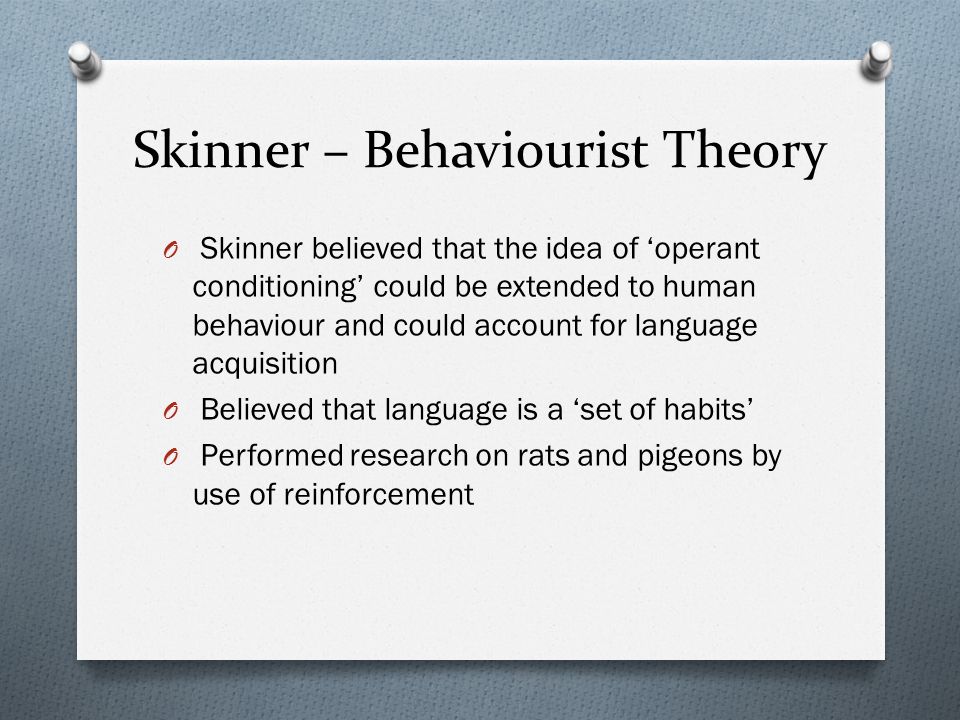 Source: slideplayer.com
Source: slideplayer.com
While most current theory may still not be the final word on second language acquisition it is hoped that teachers will use the ideas in this book as another source alongside of their classroom and language-learning experiences. They can be summarised as follows. A student gets a. This learning theory states that behaviors are learned from the environment and says that innate or inherited factors have very little influence on behavior. Behaviorial Theory behaviors such as acting thinking and feeling can be scientifically observed and measured Language as a behavior is a set of habits acquired by operant conditioning and reinforcement developed by B.
 Source: slideplayer.com
Source: slideplayer.com
A student gets a. These basic theories of language learningAcquisition are so intermingled and interwoven that no theory is completely denied or rejected. Strong emphasis on the stimulus the response and the relationship between them. Second Language Acquisition Theory There are five key hypotheses about second language. A student gets a.
 Source: pdfprof.com
Source: pdfprof.com
Second language acquisition theories initiated as an adjunct of language teaching pedagogy supported by behaviorism the leading and pioneering theory in psychology Myles 2010320. Social Interactionist Vygotsky L1 Development Theory Repeated exposure to stimuli can create learning The more frequently behavior performed more quickly it becomes habit Theory suggests that the same holds true with language. It also focuses on the role of reinforcement. The concept of the LAD at least gives a partial explanantion to the acquisition of language. This theory lays emphasis on the role played by environment and imitation.
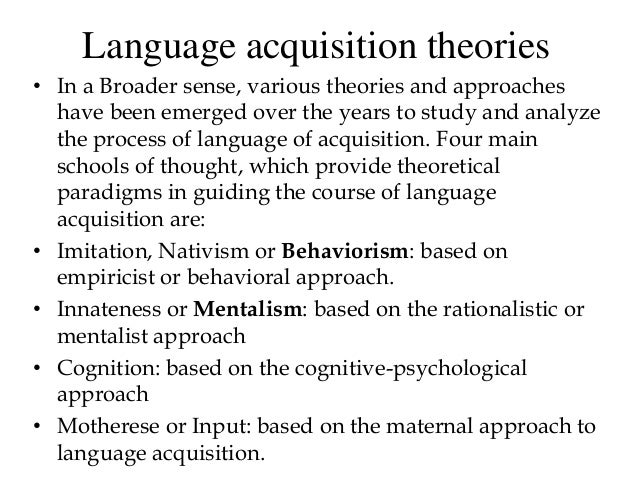 Source: pdfprof.com
Source: pdfprof.com
More frequent exposure more. Watson isactualIy atheory ofnative lan- guage learning advanced inpartasareaction totraditional grammar. For the student to acquire the second language the teacher must use reinforcement a positive reward after the student has produced the second language. Behaviorist Theory Behaviorism or Behaviorist Theory of first language L1 plays a crucial role in understanding the early importance attached to the role of the first language acquisition. This learning theory states that behaviors are learned from the environment and says that innate or inherited factors have very little influence on behavior.
 Source: pdfprof.com
Source: pdfprof.com
A common example of behaviorism is positive reinforcement. These basic theories of language learningAcquisition are so intermingled and interwoven that no theory is completely denied or rejected. Behaviorial Theory behaviors such as acting thinking and feeling can be scientifically observed and measured Language as a behavior is a set of habits acquired by operant conditioning and reinforcement developed by B. Their correct utterances are reinforced. Skinner among others 4 5.
 Source: semanticscholar.org
Source: semanticscholar.org
These basic theories of language learningAcquisition are so intermingled and interwoven that no theory is completely denied or rejected. Behaviorists like BF. Video on Behaviorist in Second Language Acquisition. A common example of behaviorism is positive reinforcement. The Behaviorists are of the opinion that Infants learn oral language from other human role models through a process involving imitation reward and practice.
 Source: prezi.com
Source: prezi.com
They can be summarised as follows. Theory Central Idea Individual with theory Behaviourist Children imitate adults. While most current theory may still not be the final word on second language acquisition it is hoped that teachers will use the ideas in this book as another source alongside of their classroom and language-learning experiences. Thus behavior is simply a response to environmental stimuli. Second language acquisition theories initiated as an adjunct of language teaching pedagogy supported by behaviorism the leading and pioneering theory in psychology Myles 2010320.
 Source: pdfprof.com
Source: pdfprof.com
Behaviorist theory which isbasicalIy apsychological theory in itsessencefounded byJB. The behaviorist theory says second language learners learn from repeated practice and being rewarded for correct answers. Strong emphasis on the stimulus the response and the relationship between them. These basic theories of language learningAcquisition are so intermingled and interwoven that no theory is completely denied or rejected. It was a dominant school of psychology from the 1920s to 1960s.
 Source: yumpu.com
Source: yumpu.com
Behaviorism is a psycholinguistic approach to language acquisition dominating the language acquisition scene in the 50s and 60s of the 20 th century viewing it as. These basic theories of language learningAcquisition are so intermingled and interwoven that no theory is completely denied or rejected. Reinforcement is key to successful transfer through behavioristic learning. Behaviorists such as Skinner explained vocabulary in order to understand and comprehension the vocabulary we associate it with motivations and responses. Theory Central Idea Individual with theory Behaviourist Children imitate adults.
 Source: pdfprof.com
Source: pdfprof.com
The concept of the LAD at least gives a partial explanantion to the acquisition of language. That is when we observe the process of language acquisition in children we notice the child acquires certain word by linking it to the object as well linking a particular response with a word. While most current theory may still not be the final word on second language acquisition it is hoped that teachers will use the ideas in this book as another source alongside of their classroom and language-learning experiences. The Behaviorists are of the opinion that Infants learn oral language from other human role models through a process involving imitation reward and practice. Five basic language learning theories are fundamental pillars of language learning whose relevance to education is undeniable.
 Source: slidetodoc.com
Source: slidetodoc.com
Skinner who lived from 1904-1990 argued that language acquisition and development are learned behaviors. Thus behavior is simply a response to environmental stimuli. They can be summarised as follows. Five basic language learning theories are fundamental pillars of language learning whose relevance to education is undeniable. The Behaviorists are of the opinion that Infants learn oral language from other human role models through a process involving imitation reward and practice.
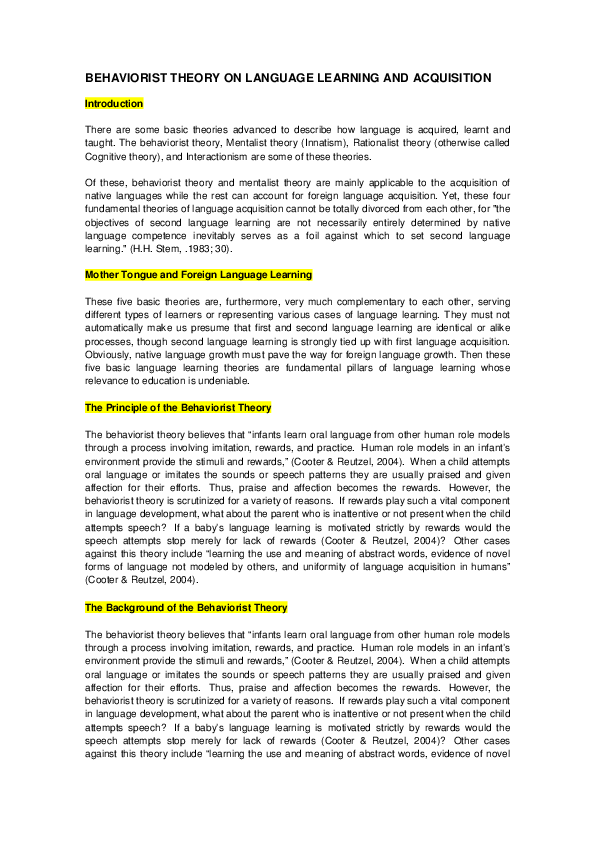 Source: academia.edu
Source: academia.edu
Going back to the early years of language learning and teaching the behaviorist approach was dominant in the area of second language acquisition Sarem Shirzadi 2014. Going back to the early years of language learning and teaching the behaviorist approach was dominant in the area of second language acquisition Sarem Shirzadi 2014. This learning theory states that behaviors are learned from the environment and says that innate or inherited factors have very little influence on behavior. THEORIES OF LANGUAGE ACQUISITION Over the last fifty years several theories have been put forward to explain the process by which children learn to understand and speak a language. Behaviorist Theory Behaviorism or Behaviorist Theory of first language L1 plays a crucial role in understanding the early importance attached to the role of the first language acquisition.
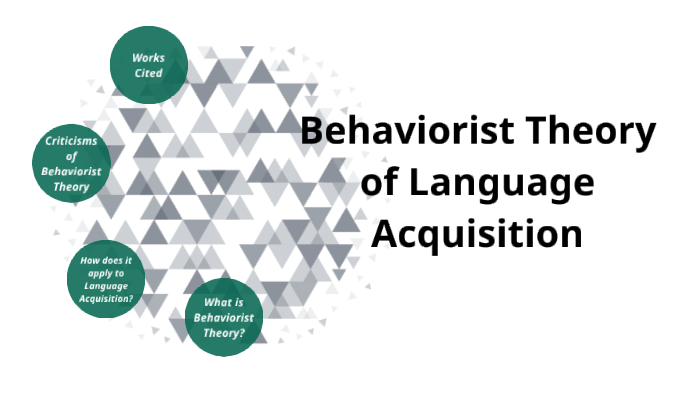 Source: prezi.com
Source: prezi.com
Theory Central Idea Individual with theory Behaviourist Children imitate adults. That is when we observe the process of language acquisition in children we notice the child acquires certain word by linking it to the object as well linking a particular response with a word. Behaviorism is a psycholinguistic approach to language acquisition dominating the language acquisition scene in the 50s and 60s of the 20 th century viewing it as. Thus behavior is simply a response to environmental stimuli. This learning theory states that behaviors are learned from the environment and says that innate or inherited factors have very little influence on behavior.
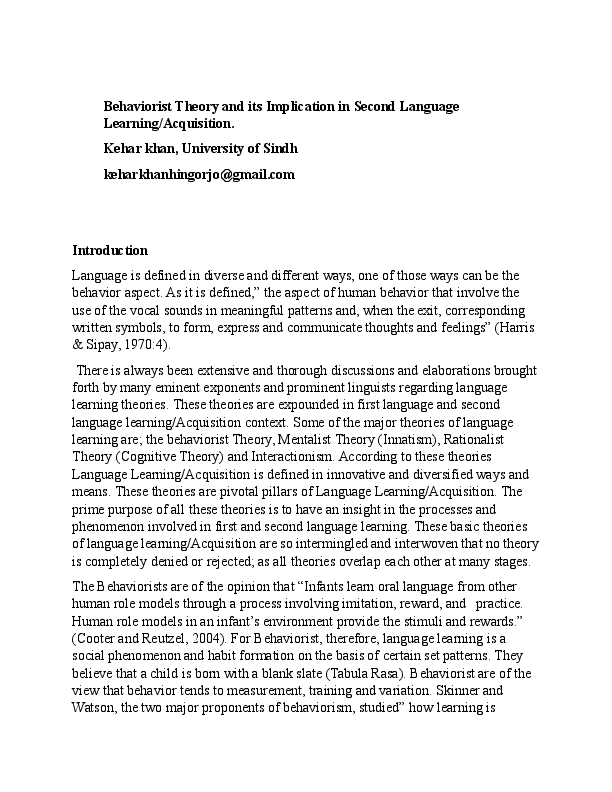 Source: academia.edu
Source: academia.edu
This learning theory states that behaviors are learned from the environment and says that innate or inherited factors have very little influence on behavior. Mentalist vs Behaviorist. Five basic language learning theories are fundamental pillars of language learning whose relevance to education is undeniable. A student gets a. Behaviorist theory which isbasicalIy apsychological theory in itsessencefounded byJB.
 Source: termcoord.eu
Source: termcoord.eu
THEORIES OF LANGUAGE ACQUISITION 3 The main theories of language acquisition and how they differ First of all the Behaviourist theory claims that language is constructed thanks to the exposure and positive reinforcement. Behaviorists such as Skinner explained vocabulary in order to understand and comprehension the vocabulary we associate it with motivations and responses. Video on Behaviorist in Second Language Acquisition. They can be summarised as follows. Theory Central Idea Individual with theory Behaviourist Children imitate adults.
 Source: slidetodoc.com
Source: slidetodoc.com
Language Acquisition Theories. Summary of Part II. The Behaviorists are of the opinion that Infants learn oral language from other human role models through a process involving imitation reward and practice. More frequent exposure more. Five basic language learning theories are fundamental pillars of language learning whose relevance to education is undeniable.
This site is an open community for users to do submittion their favorite wallpapers on the internet, all images or pictures in this website are for personal wallpaper use only, it is stricly prohibited to use this wallpaper for commercial purposes, if you are the author and find this image is shared without your permission, please kindly raise a DMCA report to Us.
If you find this site helpful, please support us by sharing this posts to your preference social media accounts like Facebook, Instagram and so on or you can also bookmark this blog page with the title behaviorist theory of language acquisition summary by using Ctrl + D for devices a laptop with a Windows operating system or Command + D for laptops with an Apple operating system. If you use a smartphone, you can also use the drawer menu of the browser you are using. Whether it’s a Windows, Mac, iOS or Android operating system, you will still be able to bookmark this website.






